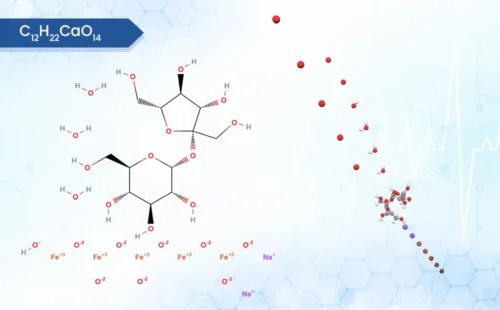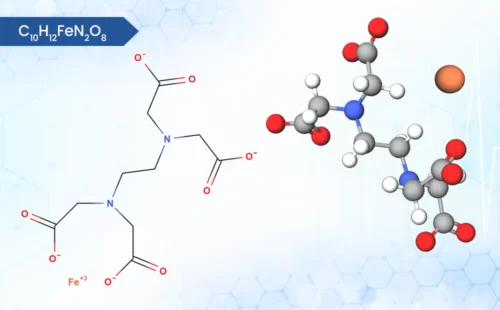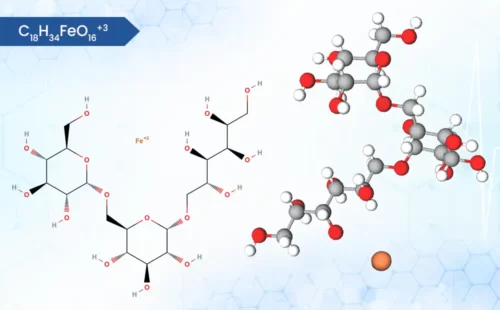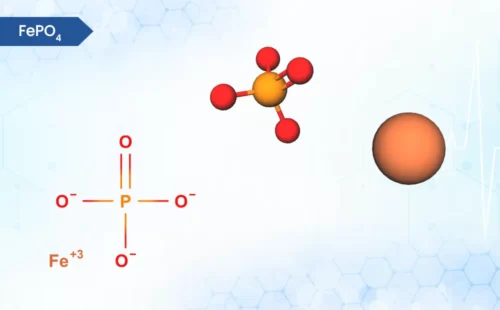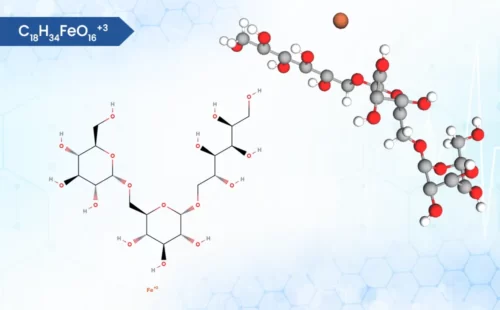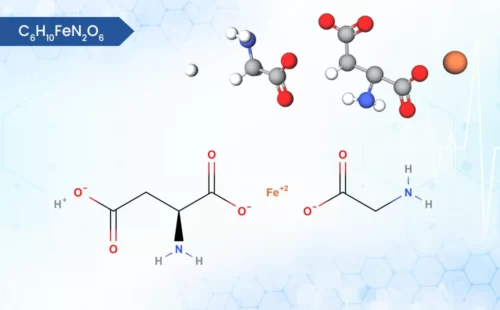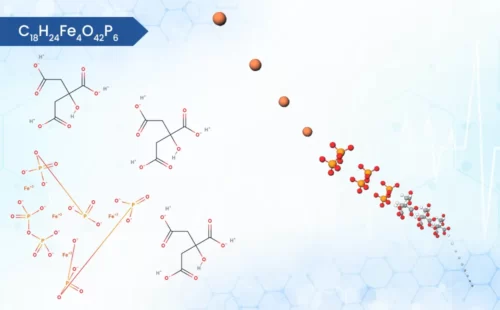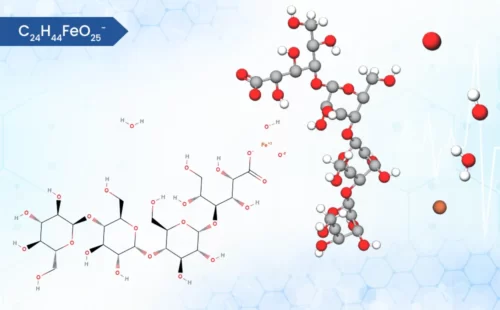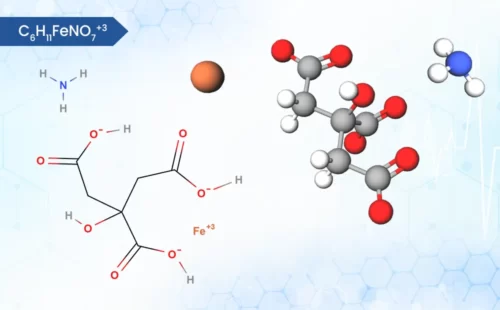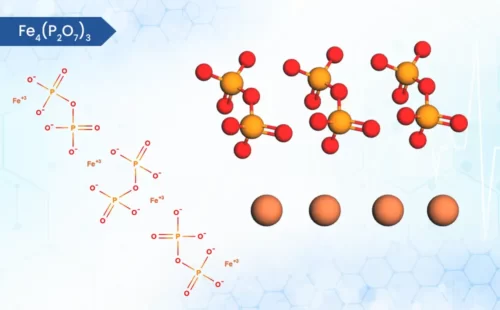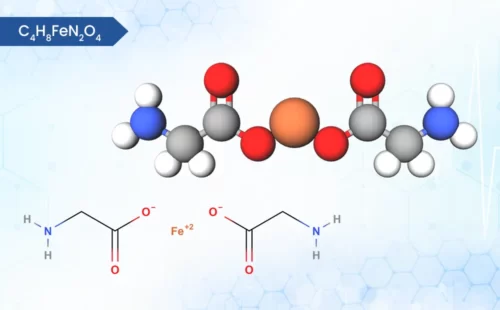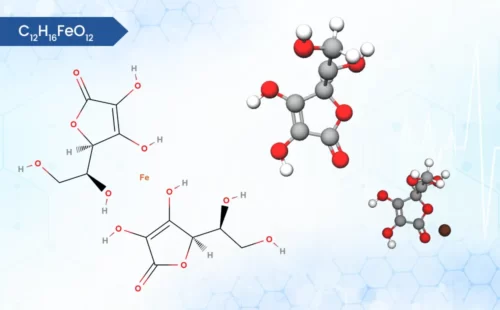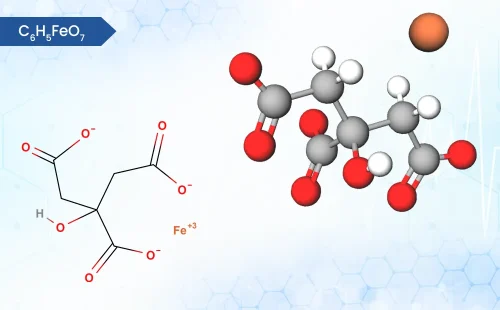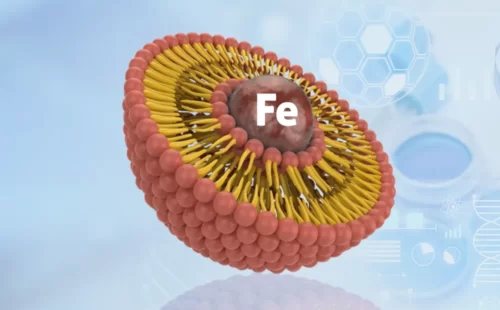-
Product Name:
Iron Sucrose
-
Molecular Formula:
C12H29Fe5Na2O23
-
Molecular Weight:
736.1 g/mol
-
CAS No.:
8047-67-4
-
HSN Code:
30049099
-
CID Code:
91663255
-
Shelf Life:
3 years - 20°C powder
-
ATC Code (WHO)
B03AB02
-
DrugBank ID
09146
-
ChemSpider ID
32699616
-
UNII No.
FZ7NYF5N8L
- USP
- IUPAC Names
- Synonyms
- MSDS
USP of Iron Sucrose
- Iron Sucrose is safer than older intravenous iron formulations as it is bit economic.
- The incidence of severe allergic reactions to iron sucrose is generally low.
IUPAC Names of Iron Sucrose
disodium;(2R,3R,4S,5S,6R)-2-[(2S,3S,4S,5R)-3,4-dihydroxy-2,5-bis(hydroxymethyl)oxolan-2-yl]oxy-6-(hydroxymethyl)oxane-3,4,5-triol;iron(3+);oxygen(2-);hydroxide;trihydrate
Synonyms of Iron Sucrose
- D-Glucaric acid, iron(2+) salt (1:1)
- Ferri Saccharate
- ferri-saccharate
- ferric oxide, saccharated
- ferric saccharate
- iron oxide (saccharated)
- Iron Saccharate
- iron sucrose
- iron(III)-hydroxide sucrose complex
- iron-saccharate
- Saccharated Ferric Oxide
- Saccharated iron
- Saccharated iron oxide
- Sucroferric oxyhydroxide
- Saccharated ferric oxide
MSDS of Iron Sucrose
Download MSDS PDF- General advice: Consult a physician. Show this safety data sheet to the doctor.
- If inhaled: If breathed in, move person into fresh air. If not breathing give artificial respiration.
- In case of skin & eye contact: In case of eye, rinse with plenty of water, and in case of skin, wash with plenty of soap and water.
- If swallowed: Never give anything by mouth to an unconscious person. Rinse Mouth with water.
- Flammability of the Product: Non-flammable.
- Auto-Ignition Temperature: Not applicable.
- Flash Points: Not applicable.
- Flammable Limits: Not applicable.
- Products of Combustion: Not available.
- Fire Hazards in Presence of Various Substances: Not applicable.
- Explosion Hazards in Presence of Various Substances:
Risks of explosion of the product in presence of mechanical impact: Not available.
Risks of explosion of the product in presence of static discharge: Not available. - Fire Fighting Media and Instructions: Wear a self-contained breathing apparatus and chemical protective clothing.
- Special Remarks on Fire Hazards: Toxic fumes.
- Special Remarks on Explosion Hazards: Do not inhale explosion and combustion gases. Collect contaminated fire extinguishing water separately. This must not be discharged into drains. Move undamaged containers from immediate hazard area if it can be done safely.
- Engineering Controls: Use process enclosures, local exhaust ventilation, or other engineering controls to keep airborne levels below recommended exposure limits. If user operations generate dust, fume or mist, use ventilation to keep exposure to airborne contaminants below the exposure limit.
- Personal Protection: Safety glasses. Lab coat. Dust respirator. Be sure to use an approved / certified respirator or equivalent. Gloves.
- Personal Protection in Case of a Large Spill: Splash goggles. Full suit. Dust respirator. Boots. Gloves. A self-contained breathing apparatus should be used to avoid inhalation of the product. Suggested protective clothing might not be sufficient; consult a specialist BEFORE handling this product.
- Exposure Limits: TWA: 1 (mg/m3) from ACG IH Consult local authorities for acceptable exposure limits.
- Appearance: Powder
- Odor: Not available.
- Taste: Not available.
- Color: Deep Brown
- Solubility: Soluble in warm Water
- Specific Gravity: Not available
- Vapour Pressure (mm Hg): Not applicable
- Vapour Density (Air = 1): Not available
- Molecular Weight: 736.06 g/mol
- pH: 9.5 – 11.5

Description of Iron Sucrose
Iron sucrose (IS) is an intravenous iron therapy that consists of iron (Fe3+) complexed with sucrose, a common sugar molecule. Upon administration, iron sucrose dissociates into iron and sucrose in the bloodstream. This configuration is designed to enhance the bioavailability and gradual release of iron and minimizes gastrointestinal side effects often associated with oral iron supplements.
Iron sucrose is particularly effective in replenishing iron stores in patients with chronic kidney disease and those undergoing hemodialysis, offering a targeted and efficient alternative to traditional iron therapies.
Application of Iron Sucrose
- Intravenous Iron Supplementation in Dialysis-Independent Patients
- Chronic Kidney Disease (CKD) Patients
- Gynecological and Obstetric Conditions
- Inflammatory Bowel Disease (IBD)
- Post-Surgical Anemia
Iron sucrose is an intravenous iron therapy commonly used for:
- Iron Deficiency Anemia (IDA): Effective in treating anemia caused by iron deficiency, especially in patients who cannot tolerate oral iron supplements.
- Chronic Kidney Disease (CKD): Essential for managing anemia in CKD patients, particularly those undergoing dialysis.
- Pregnancy: Used to treat iron deficiency anemia in pregnant women to ensure maternal and fetal health.
- Post-Surgical Recovery: Helps in replenishing iron stores after significant blood loss during surgeries.
- Cancer-related Anemia: Beneficial for patients experiencing anemia due to chemotherapy or radiation therapy.
Side effects of Iron Sucrose:
The side effects of iron sucrose can vary in severity and frequency.
- Hypotension (low blood pressure)
- Nausea
- Vomiting
- Headaches
- Dizziness
- Muscle cramps
Iron sucrose is an iron replacement medication delivered intravenously (IV) to treat iron deficiency anemia, especially in chronic kidney disease (CKD) patients. It replenishes iron stores by delivering iron sucrose particles into the bloodstream, which are then taken up by cells.
Iron sucrose bypasses the digestive system, avoiding issues like poor absorption and gastrointestinal side effects common with oral iron.
Treatment duration varies depending on iron stores repletion and can involve multiple doses.
Iron sucrose can decrease the absorption of certain antibiotics, antifungal medications, and bone-modifying drugs. It’s crucial to inform your doctor about all medications you take.
Iron sucrose is generally well-tolerated in patients with CKD, unlike some oral iron supplements that can worsen kidney function.
Blood tests to measure iron levels (hemoglobin, ferritin) are used to assess the effectiveness of iron sucrose therapy.


